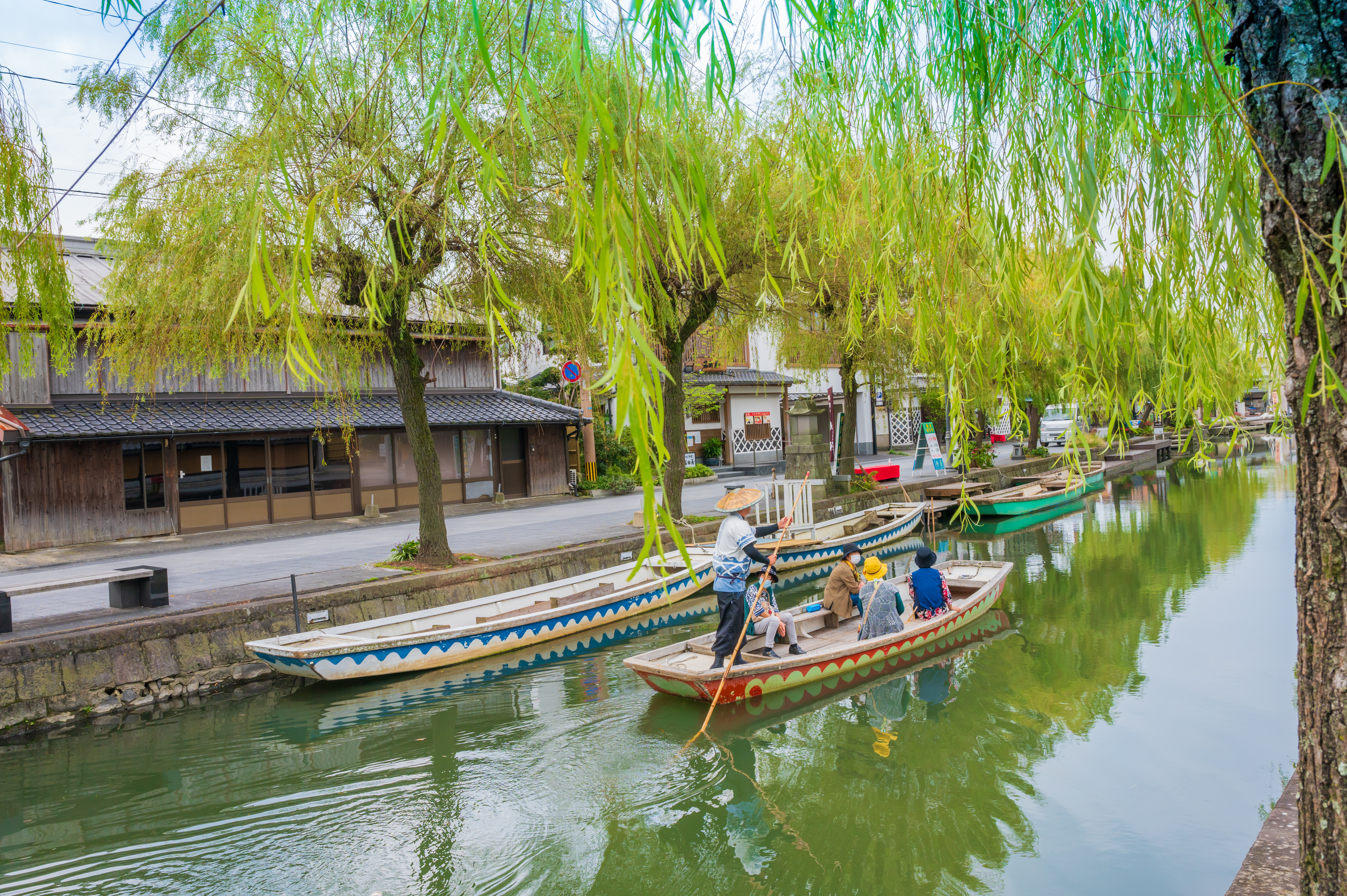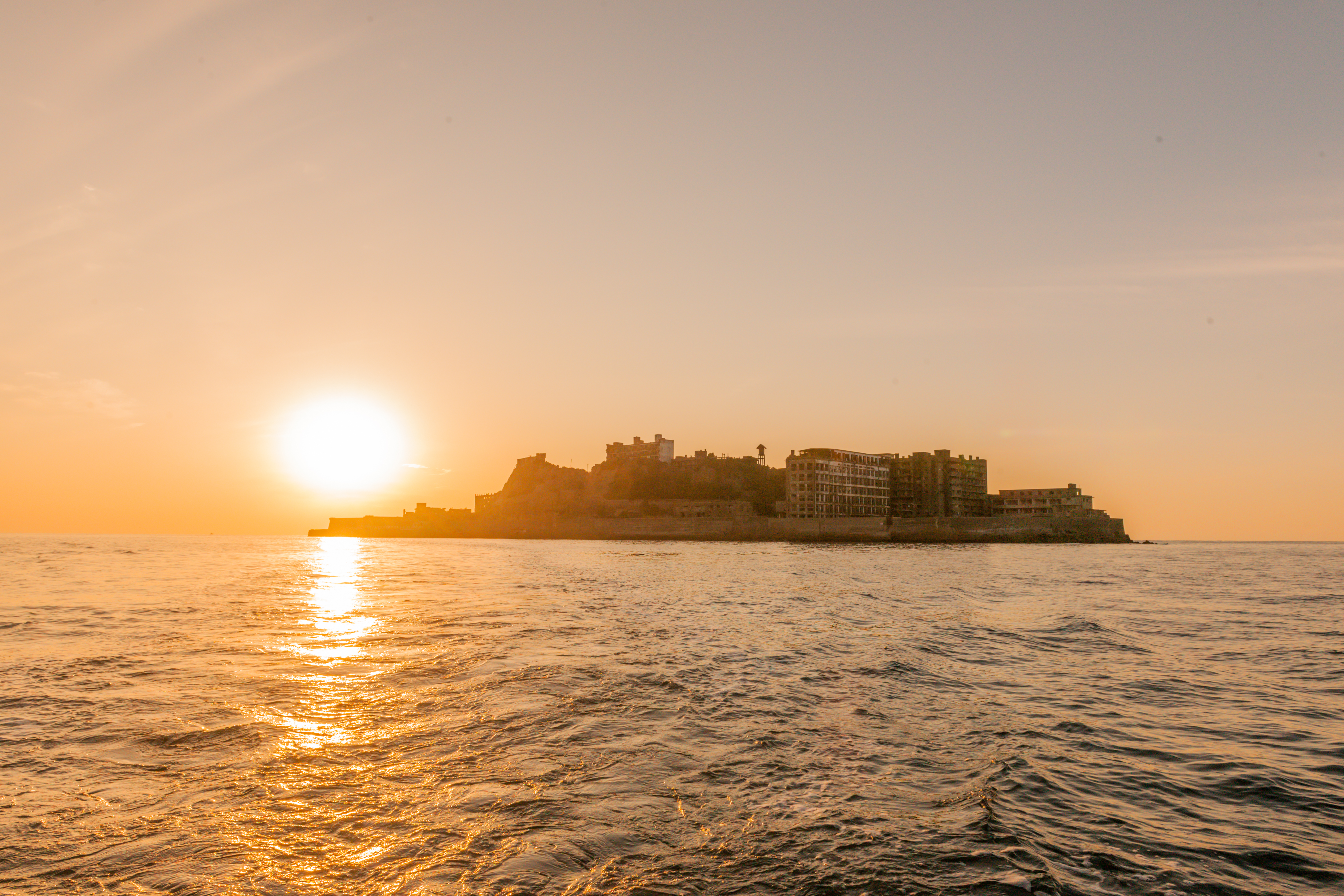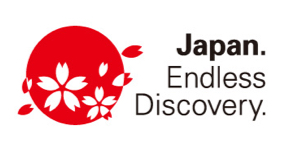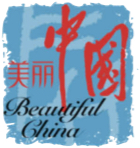3 days
History and Heritage of Kyushu
The first day of the tour begins at Nishitetsu Fukuoka (Tenjin) Station in downtown Fukuoka. With a population of around 1.6 million, this is the largest city on Kyushu – but it doesn’t feel that way. The city of Fukuoka, which shares its name with the prefecture around it, is a leafy town with a chilled atmosphere, emblematic of Kyushu as a whole.
You’ll most likely have spent the night at a nearby hotel, so this morning you’ll head out to meet an English-speaking assistant at the station. They’ll help you collect all the tickets you’ll need for the next three days and show you to your first train.
You’re headed to Yanagawa, a 16th-century town an hour to the south that’s criss-crossed with gorgeous canals. Once used to irrigate this strategic castle town, these days the canals mostly carry tourists on donkobune, boats punted by pilots in traditional garb. These picturesque waterways are thronged with beautiful trees and architecture, making it a popular day trip for locals and foreigners alike. The cruise will take around an hour, and once you’ve disembarked it’s time to find some lunch. We suggest a particular Yanagawa delicacy: unagi seiromushi.
This is steamed eel served with shredded egg on a bed of rice. It's enjoyed around these parts for hundreds of years, so each restaurant has its own secret recipe for the sweet, salty sauce that comes with it.
Once you’ve eaten your fill, it’s time to return to Fukuoka. The centrally located Canal City Fukuoka Washington Hotel is walking distance from Tenjin Station. You’ll check in around 3pm, and then the rest of the afternoon is yours. Some people might just want to wander the streets of Canal City (which is how this part of central Fukuoka is known), though we suggest a visit to the nearby Kushida-jinja Shrine – Hakata’s guardian shrine and one of the oldest religious sites in Japan.
Said to have been founded in 757, the current incarnation of the shrine was built in the 16th century. It’s home to one of the yamakasa, a richly decorated, traditional festival float used during the annual Hakata Gion Yamakasa Festival each July, when the whole city turns out to celebrate summertime and good health. Also in the vicinity is the hip Canal City shopping district, Tochoji Temple (which hosts the largest wooden Buddha in Japan), and numerous
museums and galleries.
Dinner is up to you tonight, though there are two types of food Fukuoka is especially famous for: yatai and tonkotsu ramen. The former is traditional street food, served piping hot from small wooden cards and eaten as you walk, while the later is more modern – a thick, creamy pork broth served with mushrooms, shallots, seaweed and slow-boiled egg. It’s popular across the world, but ramen fans travel here from all over Japan to sample it in the place it was invented.
Breakfast will be served at your hotel, before you check out and make your way to nearby Hakata Station. Your first destination today is Takeo Onsen, a spa town with a very long history.
You’ll arrive at around 9:30, and head straight to Yumotoso Toyokan, a ryokan – a Japanese-style travellers’ inn – and your hotel for the night. You’ll have enough time to check in and leave your luggage, but don’t dawdle because you’re headed straight to the Takeo Shrine for a lesson in the ancient art of yabusame. For those of you who don’t speak medieval Japanese, this means horse archery!
This is a local tradition dating back more than 800 years, and a unique glimpse into a samurai culture that is still passed down through the generations. You’ll strap into period gear and take shots at static targets using a training bow. The experts can hit a bullseye from great distances while galloping at full pelt, but as a beginner you’ll be learning at close range on a horse which stays still! This thrilling activity is suitable for children and people without riding experience, and there are trained instructors every step of the way.
The package lasts around an hour, and you’ll certainly have worked up an appetite, so it’s time for a spot of lunch. Saga is known for its beef, and there are plenty of ways to try it. If you’re feeling fancy, try the Saga wagyu, luxury steak from pampered cattle with the highest standards of welfare.
After lunch you’ll return to Takeo Station for a 15-minute journey west to Arita, the birthplace of Japanese porcelain, which took European high society by storm (and made Kyushu rich!) during the Victorian era. The delicate craftsmanship and elegant patterning that once so impressed royalty is still made to this day, and you’ll visit Kouraku Kiln to learn a little bit about the history of Arita ware. There’s also a treasure hunt opportunity, in which you are let loose in the warehouse with a basket to grab whatever catches your fancy. You can post it all home with you, with boxes and packing material provided.
Upon your return to Takeo, you’ll return to the hotel to freshen up before a free evening to explore. Takeo is bursting with natural geothermal energy, and it’s rightly famous for its italic – fresh, natural hot-spring baths. The Japanese love to soak away the cares of the day in a steaming-hot onsen, and this is one of the best places in Japan to experience the healing and revitalising properties of the mineral-rich local waters. There’s an onsen at your hotel,and the alkalinity of the waters in Takeo is known to be particularly good for your skin.
Dinner will be served at your hotel this evening. Takeo itself is a picturesque town, and once you’ve finished eating, we suggest exploring it in the evening cool.
You’ll once again enjoy a hearty breakfast at your hotel – tuck in, because you’ll need fuel for the day ahead. You’re about an hour out into Nagasaki Bay by ferry for an unforgettable visit to Gunkanjima – known to locals as Battleship Island.
But first you’ll catch the Bullet Train from Takeo to Nagasaki, depositing your bags at the tourist office at the main station – don’t worry, they’ll be delivered ahead of time to your hotel. From there it’s on to the Gunkanjima Museum and then the ferry terminal.
Battleship Island is actually a nickname – its real name is Hashima – but iit's certainly appropriate. This tiny 16-acre island is almost entirely concreted over, and was once home to more than 5,000 coal miners and their families. They were all packed into apartment blocks, with amenities including a school, a hospital, a cinema, communal baths, shops, and even a swimming pool. The island was all but abandoned in the 1970s when the undersea coal ran out, but it’s still mostly intact. These days, it’s a UNESCO World Heritage Site – and you may also recognise it from the James Bond movie Skyfall, where it served as the villain’s base of operations.
You’ll tour the island with a guide, returning to Nagasaki itself in time for a late lunch. As a city of almost half a million residents there’s loads of choice, though we suggest champon, the local style of noodles. These are simmered in a rich broth filled with tasty meat and fried onions, cabbage and carrot, topped off with seafood, mushrooms, sake and some soy sauce. It’s delicious!
This afternoon, you have free time set aside to explore Nagasaki. You may know it as one of the two Japanese cities attacked with nuclear weapons in World War 2, and there is a Peace Park and museum near the epicentre of the attack. Nagasaki was for almost three centuries the sole port in Japan open to Christian traders, and there is plenty of history from this period still in existence. These Portuguese and Dutch traders were once confined to Dejima, a small man-made island out in the bay – but as the city grew, this area was slowly surrounded by reclaimed land. It’s now part of the city proper, and exists as a living museum.
Nagasaki has always been cosmopolitan due to its position at Japan’s western edge, and some of its people converted to Christianity around this time. The authorities tried to put a stop to this, leaving a community of so-called ‘Hidden Christians’ in the countryside and nearby islands, who left monuments to their existence in and around the region, including Oura Cathedral, another UNESCO World Heritage Site. We also recommend Mt Inasa, a small mountain near the city centre which provides unparalleled views of the rest of the city. Once you’re done, you’ll pick up your luggage and check in at your hotel, the four-star Luke Plaza Hotel. Dinner will be served at the in-house restaurant.
You’ll eat breakfast at your hotel this morning, before checking out of the hotel and embarking upon the next leg of your tour. Whether that’s catching a connecting flight or the Bullet Train back to Tokyo to fly home, or going onto somewhere else in Japan, is up to you.
Dates & Prices
- Board: Three nights at hotels
- Meals: Three breakfasts, two dinners
- English-speaking assistant: At Tenjin Station
- Entrance and activity fees: Per itinerary
- Limited express train ticket: From Hakata to Takeo-onsen
- Bullet Train ticket: Second class reserved from Takeo-onsen to Nagasaki
- International and domestic flights
- Local transport: Train and bus per itinerary
- Taxi between Arita station to Kouraku Kiln: Approx. 2,000 JPY
- Luggage delivery service at Nagasaki: 1,000 JPY
- Certain meals: Per itinerary
- Personal expenses
- Other items not mentioned in the itinerary
- Travel Insurance.
Accommodation
As mentioned in the itinerary, subject to availability.
Signature Experiences for This Tour
This charming tour extension explores Fukuoka, Saga and Nagasaki in Japan’s scintillating western isles.
This package is for families with older kids on their school summer holidays, so the ideal timeframe is between late
June and early September. It’s designed to be added to longer trips – and it would suit visitors here for their first
or second time.



DURATION Four days and three nights
ARRIVAL The tour begins at Nishitetsu Fukuoka, (Tenjin) Station in downtown Fukuoka
DEPARTURE The tour ends at the Luke Plaza Hotel in central Nagasaki
WHEN TO VISIT Any time from Spring to Autumn
Highlights
Far away from the cityscapes of mainland Japan lies the island of Kyushu, Japan’s western paradise. This is the
historic gateway to the Land of the Rising Sun, and life is just that little bit slower here. Forget Tokyo – Kyushu is a
land of rolling hills, verdant forests and rugged coastlines, a cosy countryside offering the friendliest of welcomes.
This tour offers a taste of Kyushu and its long history of hospitality over three days, visiting the neighbouring
northern prefectures of Fukuoka, Saga and Nagasaki, and getting a little feel for each place. You’ll go punting in a
pretty canal town, learn the samurai art of horse archery, and follow in the footsteps of James Bond with a visit to
Battleship Island.
There’s something here for everyone, and this is the perfect extension for people who’ve already experienced the
delights of the mainland, and who want to enjoy a different side of Japan.
Check availability instantly and secure your reservation NOW via CHECK and BOOK
We Magical Explorer Ltd reserve our copyright, please contact us to obtain permission for use of any photos or literature from this site.
We thank our friends at the Japan National Tourist Organisation and partners for use of various images on this site.
How to book
Hidden Wonderland of Japan
Grand Japan Tour
Wonders of Japan
Japan Explorer
Classic Japan
Cultural Japan
Magical Japan
Japan Cherry Blossom Tour
Discover Japan's Northern Wilderness
The Roof of Japan
A Japanese Adventure
History and Heritage of Kyushu
Luxury and Gastronomy in Hokkaido and Beyond
Nature’s Fireworks in Hokkaido
Japan Autumn Leaves tour



Sign up to our newsletter for special offers and updates

Our Company is based in Cheshire, UK. Our tours are available to all English speaking customers living across the world and we have many customers from USA, Canada and Australia.
We now bring exclusive online cultural and wellbeing experiences to you!
Magical ExplorerSaturday: 10:00am - 4:00pm
Please complete the contact form below and one of our tour specialists will contact you within 24 hours.